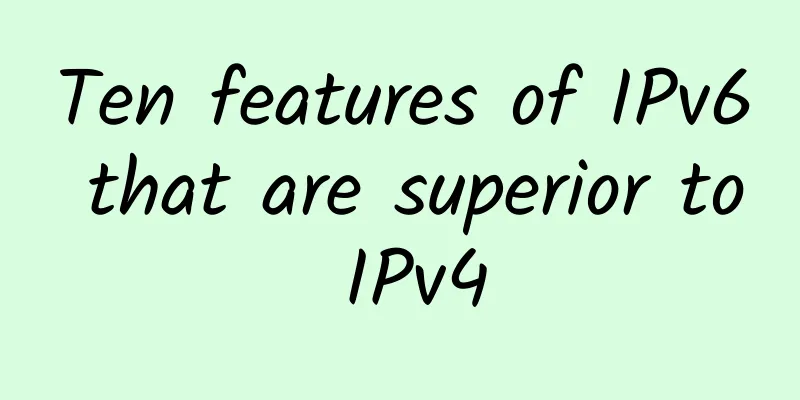Ten features of IPv6 that are superior to IPv4

|
It is 2019, and there is a serious problem that bothers veteran otaku Ergouzi. That is, there are no new names for idol groups. Starting this year, the idol group XKB48 can no longer take on any new names. All the permutations and combinations have been baptized by the long river of history. Unless the number of idols changes from 48, they will have to be called "XXKB48" starting this year. In addition to not having enough idol names, Er Gouzi also found that the public IP addresses of the servers used for the fan website were also insufficient. Although it is already 2019, Er Gouzi still prefers to use IPv4. The fan website that is powered by love must use auspicious numbers. However, after Er Gouzi found an article from 2019, he chose IPv6 without hesitation. The title of the article is straightforward: "10 Reasons Why IPv6 Is Better Than IPv4." Let's take a look at what the article says. Larger IP address space Every computer or online device that needs to connect to the Internet requires a globally unique IP address. IPv4 uses 32 bits as the IP address length, allowing about 4 billion unique IP addresses. When IPv4 was introduced and accepted as the Internet protocol in the 1970s, they did not foresee the popularity of the Internet. Therefore, people at that time firmly believed that these 4 billion addresses would be enough to cope with the future Internet environment. Today, the earth's population is about 6.6 billion, while the Internet's population is only 1.3 billion, not even 22% of the world's population. It is obvious that more and more people will be connected to the Internet in the near future. In addition, with the great progress in converging communication technologies such as data, audio, video, and voice through IP, there is still a huge room for the development and expansion of the Internet. Methods such as Network Address Translation (NAT) are used to convert between a unique global IP address and multiple private IP addresses. For example, people with dial-up service share a modem between ten users, saving about 90% of the addresses, compared to the situation where each user has a unique global IP address. In addition, even corporate users adopt the same method to let many computers share one address, thereby saving addresses. However, this brings additional complexity in network hardware and software. IPv6 uses 128 bits for IPv6 address length, allowing for 3.402823669 × 10³⁸ unique addresses. To understand the scale involved, think of the entire IPv4 space as the size of a classic iPhone 4, and the IPv6 space would be the size of the Earth. From these numbers, it is possible to provide billions of addresses for everyone with IPv6 and ensure that any device that must connect to the Internet has a unique IP address. The first advantage of expanding the address space is that when there is no NAT, the complexity of network hardware and software is reduced, and it becomes simpler to configure the network environment. Secondly, it can speed up the construction of IoT homes, where different gadgets and devices in the home all want to surf the Internet, which requires each such device to have a unique IP address, its own surfboard. Finally, the large availability of IP addresses has basically eliminated most of the obstacles that have previously appeared in the comprehensive deployment of wireless and mobile devices. IPv6 provides a better end-to-end experience than IPv4 Peer-to-peer applications are the latest hot use cases for IPv6, such as large-scale online games, video conferencing (streaming), file sharing, and VoIP. In a peer-to-peer network environment, a group of computers can communicate directly with each other without the help of a central server. IPv6 with its large address space also does not rely on NAT and can ensure true end-to-end connectivity. This means that peer-to-peer applications like VoIP or streaming media can use IPv6 very effectively. More automated configuration Whenever a node enters and wishes to become part of a network, it needs to configure the corresponding IP address information and router information. In the past, when there were fewer devices and computers in the network, almost all devices and computers were statically configured and IP addresses were manually assigned. However, with the rapid growth of personal computers (PCs) and other IP-enabled devices, automatic configuration is essential for more efficient device management and resource reuse. A feature in IPv6 called Stateless Auto Configuration can complete the allocation of IP addresses without the help of a DHCP server. This special feature enables the router to easily automatically configure its interface and dynamically provide user gateways. Simplified header structure for faster routing The IPv4 header structure contains 20 bytes of data and includes optional fields, forcing intermediate routers to check whether the IP header contains optional fields. In addition, in the IPv4 data packet header, these optional fields have a certain maximum allowed size. Compared with IPv4, IPv6 has a simpler packet header structure, which is designed to minimize the time and energy required for packet header processing. It is achieved by moving optional fields and non-essential fields to an extended header that is placed only after the IPv6 packet header. Therefore, intermediate routers can process IPv6 packet headers more efficiently without having to parse the packet header or recalculate the network layer checksum, or even segment and reassemble the packet. With improved efficiency, the processing overhead of the router is reduced, the hardware does not have to be overly complex, and packets can be processed faster. Another feature of the IPv6 header structure is that there is no limit to the maximum size of the extension header. They can be expanded to accommodate any extended data required for efficient IPv6 communication. In fact, a typical IPv6 packet does not include an extension header. Only when some special processing is required by the intermediate router or destination, the host sending the packet will add one or more extension headers as needed. This new extension header makes IPv6 more flexible to cope with new needs in the future. Improved security IPv4 was designed with little consideration for security, especially in end-to-end mode. In IPv6, IPSec, as the main protocol, is one of the factors that ensures that IPv6 provides better security than IPv4. IPSec consists of a set of cryptographic protocols for ensuring secure data communications and key exchange. The main protocols used are:
IPv6 therefore ensures that there are end-to-end security mechanisms that provide authentication and encryption capabilities for all applications, eliminating the need for integrated support for these capabilities in the applications themselves. An additional benefit of using the same security mechanisms for all applications is that setting up and managing security policies becomes much simpler. IPv6 allows for complete end-to-end security, thereby allowing the deployment of a new set of personalized services, such as mobile e-commerce services that rely on secure transactions. Better Quality of Service (QoS) The IPv6 header contains a new field called the Flow Label field, which defines how routers identify and process specific packets, thereby ensuring that the information is not modified by intermediate systems during transmission. Therefore, it has good QoS, and applications with high real-time information such as VoIP often prefer IPv6. Better multicast and anycast capabilities IPv6 not only extends the multicast function of IPv4 by providing a large multicast address range, but also greatly changes the concept of anycast, making anycast more widely applicable. Better support for mobile devices IPv6 ensures that each mobile device can have its own IP address through its huge address space. And it has a dedicated MIPv6 protocol, which allows fast switching between different access technologies, such as from cellular networks to wireless networks, without noticeable impact on ongoing connections. Easier to manage When you want to expand an existing network, merge two networks, or change service providers, the network needs to be renumbered and assigned a new address scheme. In IPv6, network renumbering can be done automatically. Therefore, network renumbering with IPv6 will no longer require manual reconfiguration of each host and router, resulting in smoother switchover or merge operations. Follow the key design principles of IPv4 to make the transition smoother IPv4 has been successfully deployed around the world for many years, and its wide-scale use has proven the success of IPv4 design. Therefore, IPv6 follows many of the same design points, making a smooth transition from IPv4 to IPv6 possible. Currently, there are many popular applications on the market that require IPv6, attracting more and more users to join the ranks of IPv6 users. However, IPv4 applications will still exist for some time to come, and the transition from IPv4 to IPv6 must be a gradual process. |
>>: Wi-Fi 6 Column | Is Wi-Fi 6 omnipotent?
Recommend
RackNerd: $194/month cluster server-E3-1240v3/16GB/1TB/30TB/237IP/Los Angeles and other data centers
We have shared information about RackNerd many ti...
What is Wi-Fi 7?
The Wireless Broadband Alliance (WBA) announced i...
HTTP also has long and short connections? HTTP long connection vs. short connection
You must have heard about the so-called long conn...
RackNerd: $39/month-E5-2690/4GB/120GB/5TB/San Jose & Seattle & Dallas, etc.
The tribe has shared a lot of cheap RackNerd VPS ...
A brief discussion on Telemetry network telemetry traffic analysis technology
·Introduction· With the rapid development of clo...
Summary information: Wuyou Cloud/Cool Cloud/Lanyun/Tiansheng Cloud/Candy Host/Cool Cloud
All merchants are actively carrying out Double El...
Huawei launches intelligent network to unleash the power of ultra-broadband with intelligence
[51CTO.com original article] Hangzhou, China, Oct...
10% off on all CMIVPS VPS, starting from $2/month for Hong Kong CN2 line, starting from $16/quarter for Seattle VPS Sparta
CMIVPS sent a 10% discount code for all VPS, incl...
TmhHost Double 11: Japan/Hong Kong/US CN2 GIA high defense 20% off quarterly payment from 79.2 yuan, Hong Kong CN2/Japan CN2 monthly payment from 28 yuan
TmhHost launched a series of promotional plans du...
2021 Bots Automation Threat Report: An In-depth Analysis of Bots Attacks
Recently, as a professional manufacturer in the f...
Quick questions and answers: 20 killer questions for computer network interviews
[[414422]] This article is reprinted from the WeC...
Summary information: Cloudie.sh/Hongsuyun/Mondoze/Retslav/Crunchbits/Niuniu IDC
On weekend nights, I share with you some of the h...
AvenaCloud: €11.5/year - 1GB/10GB SSD/100M unlimited traffic/Moldova complaint-resistant VPS
AvenaCloud is a Moldovan hosting company establis...
Is it necessary to upgrade from 4G to 5G mobile phone now?
As 5G network coverage continues to expand rapidl...
5G is not about mobile phones, but about the Internet of Things.
[[321085]] Recently, new infrastructure has conti...









